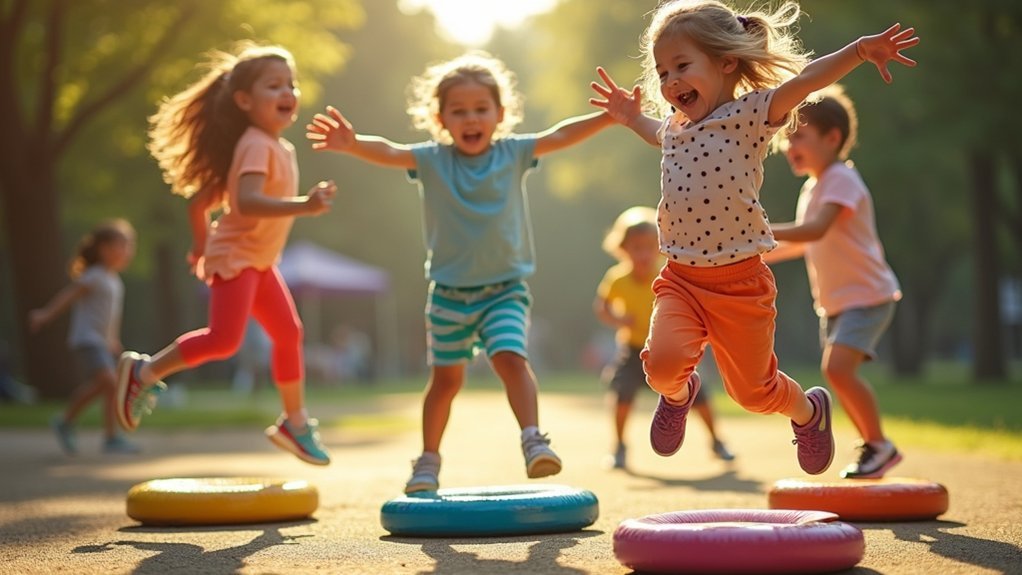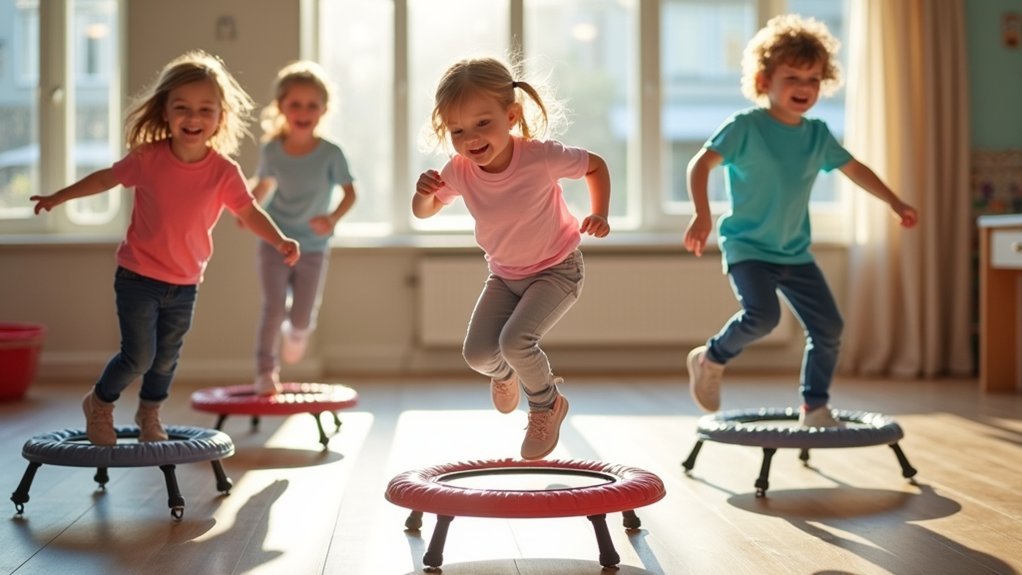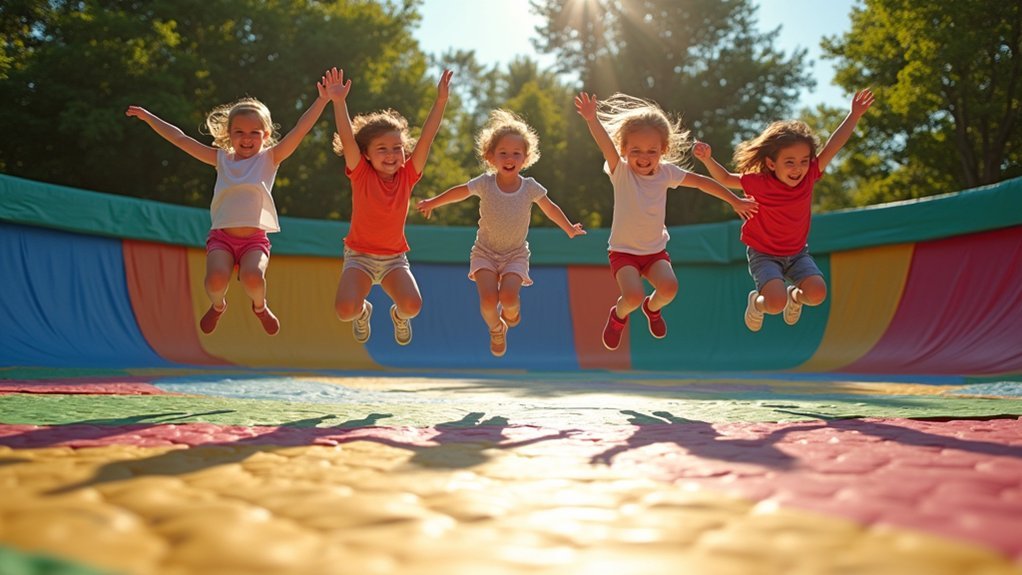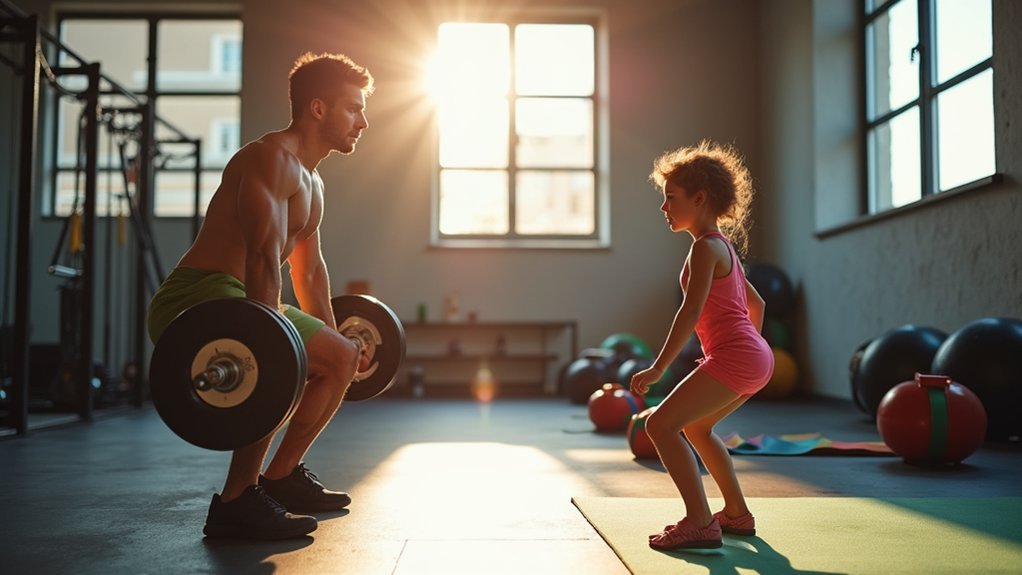Mini jumpers enhance your child’s motor skills by strengthening leg muscles, improving balance, developing core stability, and refining hand-eye coordination. They boost spatial awareness while kids navigate the bouncing surface and stimulate the vestibular system for better equilibrium. Cross-body movements strengthen neural connections, while varied jumping patterns improve proprioception. Children also develop bilateral coordination and timing through symmetrical bouncing. Discover how these fun rebounding activities transform into powerful developmental tools for your little one.
Building Leg Strength Through Bouncing Routines

While many parents focus on structured exercise programs, mini jumpers offer a playful alternative that builds essential leg strength in children.
When your child engages in repetitive bouncing activities, they’re actively strengthening their quadriceps, hamstrings, and calves with each jump.
This playful bouncing develops vital motor skills as kids learn to push off the ground with force, building explosive power in their legs.
You’ll notice improvements in their balance and coordination as they learn to control their movements mid-bounce.
The continuous nature of jumping also enhances endurance, allowing them to sustain other physical activities longer.
The engaging nature of mini jumpers guarantees your child will participate consistently, leading to gradual physical development over time—without them even realizing they’re exercising their way to stronger legs.
Enhancing Balance Control With Each Jump
Although often overlooked, the balance benefits of mini jumpers extend far beyond simple fun. Every bounce challenges your child’s core muscles, requiring them to stabilize their body while in motion, greatly improving their overall balance control.
As your little one jumps, they’re constantly adjusting their position in space, enhancing proprioception and spatial awareness with each movement. The repetitive nature of bouncing teaches effective weight shifting, an essential component of gross motor skills development.
Watch how your child coordinates their legs and arms while jumping—this synchronization builds body control that transfers to everyday activities.
The magical synchrony of jumping develops whole-body coordination that enhances everything from walking to writing.
Over time, you’ll notice increased confidence in their movements as their balance improves through this playful exercise. Mini jumpers transform simple play into a powerful tool for developing foundational motor skills.
Core Muscle Development During Rebounding

Despite appearing as simple bouncy fun, mini jumpers provide exceptional core strengthening benefits for young children. When your child rebounds, they’re constantly engaging their abdominal and back muscles to maintain balance and coordination during each bounce. This repetitive stabilization builds remarkable core strength over time.
Your child’s awareness of body positioning improves through proprioception as they jump. Their brains learn to process spatial information while their core muscles work to maintain overall stability. This enhanced body awareness translates to better posture as strengthened midsection muscles properly support the spine.
Regular rebounding sessions increase core endurance as your child performs dynamic movements that challenge their stabilization muscles. The more they jump, the stronger their foundation becomes – setting them up for success in all physical activities.
Hand-Eye Coordination Through Guided Activities
Mini jumpers offer more than just core strength benefits—they’re also exceptional tools for developing hand-eye coordination in young children.
When you incorporate guided activities like reaching for hanging toys or balloons while bouncing, you’re helping your child practice precise movements and improve visual tracking abilities.
Try structured games such as passing a soft ball back and forth during jumping sessions. These activities enhance coordination skills by requiring your child to focus on movement and object interaction simultaneously.
The repetitive bouncing motion creates neural connections that improve spatial awareness and overall coordination.
You can maximize the physical benefits of mini jumpers through creative play scenarios—have your child catch and throw objects while bouncing to integrate dynamic movement with hand-eye coordination practice.
These enjoyable activities transform exercise into developmental opportunities.
Spatial Awareness While Navigating the Trampoline Surface

When children bounce on mini jumpers, they’re developing essential spatial awareness skills that extend far beyond simple physical exercise. They learn to judge distances and heights while making quick adjustments to their body positions during each jump.
| Spatial Skill | How Mini Jumpers Help |
|---|---|
| Proprioception | Children sense body position as they bounce |
| Balance | Kids stabilize themselves on unstable surfaces |
| Coordination | Jumping requires synchronized movement patterns |
| Motor Planning | Children anticipate where they’ll land next |
You’ll notice your child’s improved spatial awareness as they confidently navigate the trampoline surface. Their brains are constantly processing their position in space, enhancing both cognitive and physical abilities. These motor skills transfer to other physical activities, making mini jumpers an effective tool for thorough development.
Rhythm and Timing Skills From Consistent Jumping
Closely connected to spatial awareness is the development of rhythm and timing—fundamental skills children acquire through regular trampoline use.
When your child jumps on a mini trampoline, they’re learning to synchronize their movements with each bounce and landing, developing essential timing skills.
The repetitive nature of jumping helps kids predict and control their physical movement, creating neural pathways that enhance coordination.
You’ll notice your child experimenting with different jumping patterns, intuitively refining their sense of rhythm with each session.
Adding music to trampoline time amplifies these benefits.
As your child jumps in sync with beats, they’re strengthening auditory processing alongside motor skills.
This rhythmic foundation transfers to other activities like dancing or playing instruments, where precise timing makes all the difference.
Cross-Body Movements for Brain Development
Beyond their physical benefits, cross-body movements performed on mini jumpers create powerful neural connections that enhance your child’s brain development.
When your kid reaches or bounces from side to side, they’re stimulating pathways between the brain’s hemispheres, integrating information more effectively.
These activities improve your child’s coordination and spatial awareness—skills that translate directly to academic success and daily functioning.
Cross-body mini jumper exercises develop coordination and spatial awareness, laying foundations for classroom learning and everyday tasks.
You’ll notice improvements in their motor skills and athletic abilities as they master these cross-lateral movements.
Encourage your kids to participate in mini jumper activities regularly.
The consistent practice of cross-body movements won’t just strengthen their muscles; it’ll boost their focus, attention span, and self-regulation abilities.
Proprioception Improvement Through Varied Jumping Patterns
Your child’s spatial awareness naturally develops when they try different jumping patterns on mini trampolines, learning to recognize their body’s position in space with each bounce and landing.
These varied movements train them to identify and repeat specific jump patterns, strengthening their proprioceptive feedback system that tells their brain where body parts are located.
As they master different jumping techniques, you’ll notice improved muscle control throughout their entire body, from their core to their limbs, creating a foundation for more complex physical skills.
Spatial Awareness Through Play
While children bounce with delight on mini jumpers, they’re actually developing essential spatial awareness skills. Their brains are mapping the environment as they learn to navigate their bodies through space. This play-based activity strengthens coordination and balance while enhancing motor planning abilities.
When your child uses a mini jumper, they’re receiving constant proprioceptive feedback about their body’s position, improving their physical development in these ways:
- They learn to gauge heights and distances as they adjust jumping force and landing positions.
- They develop neural pathways that help them understand their body’s boundaries in relation to objects around them.
- They build confidence in movement as they master different jumping patterns and successfully navigate their environment.
Jumper Pattern Recognition
Four distinct jumping patterns on mini jumpers create a foundation for developing proprioception in young children. When your child practices vertical jumps, side-to-side movements, forward leaps, and rhythmic bouncing, they’re activating neural pathways that help them sense their body’s position in space.
You’ll notice improved body awareness as your child learns to adjust their balance during these varied movements. Each pattern challenges them to develop gross motor skills differently—vertical jumps build leg strength, while side-to-side hops enhance coordination.
These structured activities help children recognize sequences while improving spatial awareness and understanding directionality. The mini jumper’s design encourages your child to navigate different movement patterns, teaching them to process where their limbs are positioned and how much force to apply—essential components of motor skills that will benefit them throughout childhood.
Muscle Control Building
Mini jumpers serve as powerful tools for developing muscle control in children, offering more than just bouncy entertainment.
When your child jumps, their body constantly makes micro-adjustments, strengthening proprioception—their awareness of body position in space. These adjustments build core strength and stability, fundamental components of advanced motor skills.
- Active Bouncing – Watch as your child’s muscles learn to contract and relax in precise sequences, improving coordination with each bounce and landing.
- Twisting Jumps – These movements challenge your child’s body awareness, forcing their brain to process spatial information while maintaining balance.
- Pattern Jumping – Creating specific jumping sequences engages different muscle groups and enhances overall development through repetitive, controlled movements.
You’ll notice improved coordination in everyday activities as their muscles learn to work together more efficiently.
Vestibular System Stimulation During Bounce Sessions
As your child bounces on a mini jumper, their vestibular system receives powerful stimulation that’s essential for developing balance and spatial awareness.
The consistent up-and-down motion activates inner ear structures responsible for maintaining postural control and stability.
You’ll notice improvements in your child’s coordination as the rhythmic bouncing enhances their brain’s ability to process sensory information.
This integration of movement and sensory input helps them develop more effective motor skills and body awareness.
For kids with sensory processing challenges, regular bounce sessions are particularly valuable.
The vertical movement doesn’t just strengthen muscles—it positively influences cognitive functions too.
When your child jumps, they’re simultaneously training their brain to organize sensory information and respond with appropriate physical actions, creating a foundation for complex movement patterns.
Bilateral Coordination Through Symmetrical Jumping Exercises
When children engage in symmetrical jumping on mini trampolines, they develop essential bilateral coordination skills that benefit their overall motor development. Your child’s brain forms stronger neural pathways as they learn to synchronize movements, improving their motor control and body awareness with each bounce.
- Watch as your child’s arms and legs work in unison during symmetrical jumping, strengthening their ability to coordinate both sides of their body simultaneously.
- Notice improved timing and rhythm in their movements as they master the up-and-down pattern on the mini jumper.
- Observe how regular trampoline practice translates to better gross motor skills in everyday activities, from tying shoes to riding bikes.
These synchronized jumping exercises create a foundation for coordination that’ll benefit your child throughout their physical development journey.
Frequently Asked Questions
How Does Jumping Help Develop Gross Motor Skills?
Jumping strengthens your core, legs and back while enhancing your coordination and body awareness. You’ll develop better neural pathways, improving motor control and spatial awareness as you engage in this fun cardiovascular activity.
How Do Children Develop Motor Skills?
You’ll develop motor skills through physical play, practice, and natural exploration. Your gross motor skills emerge as you run, jump, and climb, while fine motor skills develop when you’re manipulating small objects with precision.
Is Jumping on a Trampoline a Gross Motor Skill?
Yes, jumping on a trampoline is a gross motor skill. You’re using large muscle groups in your legs, core, and back when you bounce. It’s also developing your balance and coordination simultaneously.
What Factors Help Children Develop Their Motor Skills?
You’ll develop your child’s motor skills through regular physical activities, consistent practice, spatial awareness challenges, rhythm exercises, and social play. Balance activities and coordination games also greatly enhance their physical development.
In Summary
You’ve seen how mini jumpers offer incredible benefits for your child’s physical development. They’re not just fun—they’re powerful tools that strengthen legs, improve balance, and develop core stability while enhancing coordination skills. By incorporating regular trampoline time into your child’s routine, you’ll support their vestibular system, spatial awareness, and brain development. These jumping sessions aren’t simply playtime—they’re building the foundation for your child’s lifelong movement skills.





Leave a Reply